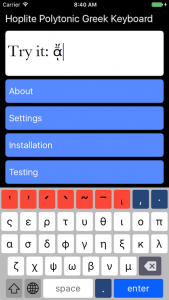Building a New Polytonic Greek Keyboard for iOS and Android

Last year, I released an Ancient Greek verb conjugation game for iOS and Android called the Hoplite Challenge. It is based on a game played in the Latin/Greek Institute’s Basic Greek summer intensive course. One of the most popular features of the app is the soft keyboard which allows the input and accentuation of Polytonic Greek characters. Now this keyboard can be installed separately as a keyboard extension on iOS and Android devices for use in other apps.
Typing Ancient Greek has always been difficult. Some Ancient Greek characters can have up to four diacritical marks which must be added to the base vowel. Making a new keyboard for mobile devices offered a chance to rethink how inputting Ancient Greek characters could be done. Since the keyboard was originally designed to be used in a game, care was given to make it fun and easy to use. In the end, six goals were identified and met in the Hoplite keyboard.
- Type the character first, diacritics second
- Diacritics can be entered in any order
- Diacritics can be individually toggled on or off without having to delete the character and start again
- One key per diacritic
- Only legal diacritics can be added to a character
- Pressing backspace deletes the character including all of its diacritics
First, the base letter should be typed first. Some Ancient Greek keyboards ask the user to press a dead key first to indicate the diacritic(s) then type the base letter. This makes it easier for the computer because everything is determined about the character before it is displayed on the screen. But the user must remember the dead key combination and, if a mistake is made, the entire character must be deleted before starting again. This leads to a frustrating process of elimination unless you have thoroughly memorized the dead keys. A more user-friendly approach is to allow the user to type the base character and then add diacritics. Second and third, the user should be allowed to add accents in any order and should be able to toggle them on or off individually in case a mistake is made. Fourth, since there is one key per diacritic, only eight dead keys must be memorized. This is easier in the case of soft keyboards because dedicated keys can be assigned and labeled for this function: no memorization is required. Fifth, the keyboard should be smart enough to prevent illegal diacritic/letter combinations. Sixth, the backspace key should work on the letter including its diacritics. If the user intends to only remove one of the diacritics it can be toggled off per goal three.
The Hoplite Keyboard has met each of these goals. What results is a keyboard which is more efficient and a joy to use. Implementing this new design was easier for mobile soft keyboards because the operating systems are more permissive regarding input methods and drawing keys on a touchscreen is more flexible than having to negotiate with physical keys.
Some difficulties remain because most system fonts on iOS and Android do not fully support polytonic Greek. Read more about polytonic Greek fonts in an upcoming post.


